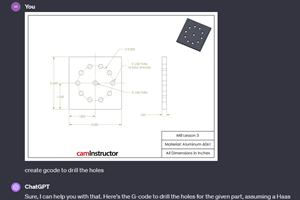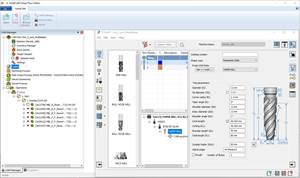Software Improves Programming-to-Machining Ratio
WorkNC from Vero Software enabled Custom Tooling Systems Inc. to increase overall efficiency while reducing programming and machining times.
Share





When CNC department manager Kevin Bouwkamp joined Custom Tooling Systems (CTS) about three years ago, he brought more than five years of CNC operator experience with him. Accustomed to working with several different software solutions, Mr. Bouwkamp realized that software limitations at CTS were preventing the company from maximizing its assets, from machines to personnel. In order for the company to grow, CTS purchased WorkNC from Vero Software (Forrest Lake, Minn.). The software has created a more efficient manufacturing environment with an improved programming-to-machining ratio.
Established in 1990, CTS focuses on the design and build of new tooling for the manufacturing industry. Core products of the Zeeland, Mich.-based company include seat pans, seat brackets and convertible brackets for Tier 1 and Tier 2 suppliers in the automotive market.
During his first few months with CTS, Mr. Bouwkamp realized that the company’s software solution was lacking fluidity. There were a lot of collisions involving cutters, and the tool paths were not as smooth as he needed them to be. Also, the software generated just 2 hours of machining time for every hour of programming—unacceptable for a company that typically works 16 to 20 hours a day and needs to use unattended machines whenever possible.
After discussing the software limitations with the company’s programmers, Mr. Bouwkamp decided it was time to explore other solutions. Because it’s typical for the design department to continually revise existing drawings, the programmers wanted a software solution that would simplify engineering changes. Also, since CTS outsources approximately 75 percent of its design work, the new software needed to work well with many different CAD programs.
“As a group, we discussed our experiences with different CAM programs and chose four solutions to begin our selection process,” he says.
In the end, the company chose WorkNC. According to Mr. Bouwkamp, the department felt confident in this selection because it was offered a free 30-day trial period, which no other CAM company offered at the time. During this trial, WorkNC came to the facility and worked directly with employees to show them the many software features. Rather than trudge through entry-level training, employees worked on actual production pieces and kept ahead of schedule.
The free training also made it possible to learn about Automatic Feature Recognition toolpath creation, which saved the company a tremendous amount of time, Mr. Bouwkamp says. For instance, when manufacturing die sets, it previously took 4 hours to program the drilling and tapping sequence. With WorkNC, programmers can create a program to drill and tap 150 holes in less than 10 minutes.
“Because all holes are color coded in WorkNC, we have eliminated the need to individually program which drill and tap to use and what depth must be taken,” he says.
Programming is no longer cumbersome and time consuming. For example, when building a stock model, staff previously set up a bounding box, placed limits on where to cut and in what direction the machine tool needed to sweep and noted where the stock ended. With WorkNC, the staff can bring in a single block, place it in any position and create the stock model.
“WorkNC knows every tool path and knows where the previous tool paths have machined. Not having to create boundaries saves a tremendous amount of time,” Mr. Bouwkamp says.
Another feature that has improved CTS’s manufacturing and programming times is the ability to program multiple blocks under one program. In such an operation, programmers can build a sequence of roughing tools, drills, reamers and finishing tools, enabling every block to be trimmed out and ready for the next operation.
Mr. Bouwkamp says the reason for some of the decrease in programming time is that programmers can lay down the tool path, drag the window off to the side and allow it to calculate while another program is started. Afterwards, the initial box can be opened to review the tool path. If it goes to an unwanted area, the programmer can simply perform a graphical edit to remove those paths.
“We cannot do that with the other software packages or solutions,” Mr. Bouwkamp says.
The enhancements that WorkNC offers has provided CTS employees with the knowledge and confidence needed to make a seamless transition from its previous solution while creating a more efficient environment.
Prior to acquiring WorkNC, CTS employed four full-time programmers on day shift and two on night shift. Since the implementation, the company has reduced the number of programmers to three, repositioning several programmers to other critical positions within the company.
While greatly improving the programming-to-machining time ratio, the new software also helped diversify CTS’s customer base. The company now generates 20 hours of manufacturing time for every hour of programming time, which enabled it to add four new machine tools, including an Awea LP-F series bridge-type, five-face machining center.
This kind of success has led CTS to purchase four WorkNC licenses within a year and a half of its initial purchase.
“WorkNC eliminates a lot of the middle and unnecessary work while providing the tools needed to increase our customer base,” Mr. Bouwkamp says.
Related Content
Orthopedic Event Discusses Manufacturing Strategies
At the seminar, representatives from multiple companies discussed strategies for making orthopedic devices accurately and efficiently.
Read MoreAdvanced Tool Paths, Simple Implementation
Programming advanced tool paths used to be a complex, time-consuming task. Canned cycles in CAM software have now made them more accessible than ever.
Read MoreCan ChatGPT Create Usable G-Code Programs?
Since its debut in late 2022, ChatGPT has been used in many situations, from writing stories to writing code, including G-code. But is it useful to shops? We asked a CAM expert for his thoughts.
Read MoreBuilding A Powerful Bridge from the CAM Programmer to the Shop Floor Operator
SolidCAM for Operators provides a powerful bridge from CAM programming to the shop floor to best streamline the machine shop process with its CAM part simulation. It provides a clear picture to the operator for setup and prove-out, enables minor G-Code changes and avoids crashes, broken tools and scrapped parts.
Read MoreRead Next
AMRs Are Moving Into Manufacturing: 4 Considerations for Implementation
AMRs can provide a flexible, easy-to-use automation platform so long as manufacturers choose a suitable task and prepare their facilities.
Read MoreLast Chance! 2025 Top Shops Benchmarking Survey Still Open Through April 30
Don’t miss out! 91ÊÓƵÍøÕ¾ÎÛ's Top Shops Benchmarking Survey is still open — but not for long. This is your last chance to a receive free, customized benchmarking report that includes actionable feedback across several shopfloor and business metrics.
Read MoreMachine Shop MBA
Making Chips and 91ÊÓƵÍøÕ¾ÎÛ are teaming up for a new podcast series called Machine Shop MBA—designed to help manufacturers measure their success against the industry’s best. Through the lens of the Top Shops benchmarking program, the series explores the KPIs that set high-performing shops apart, from machine utilization and first-pass yield to employee engagement and revenue per employee.
Read More























